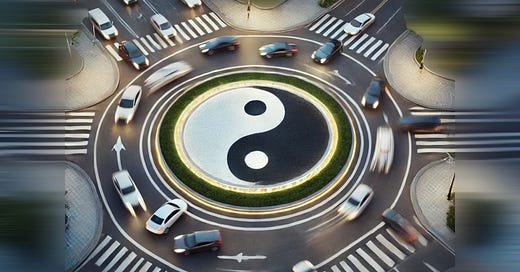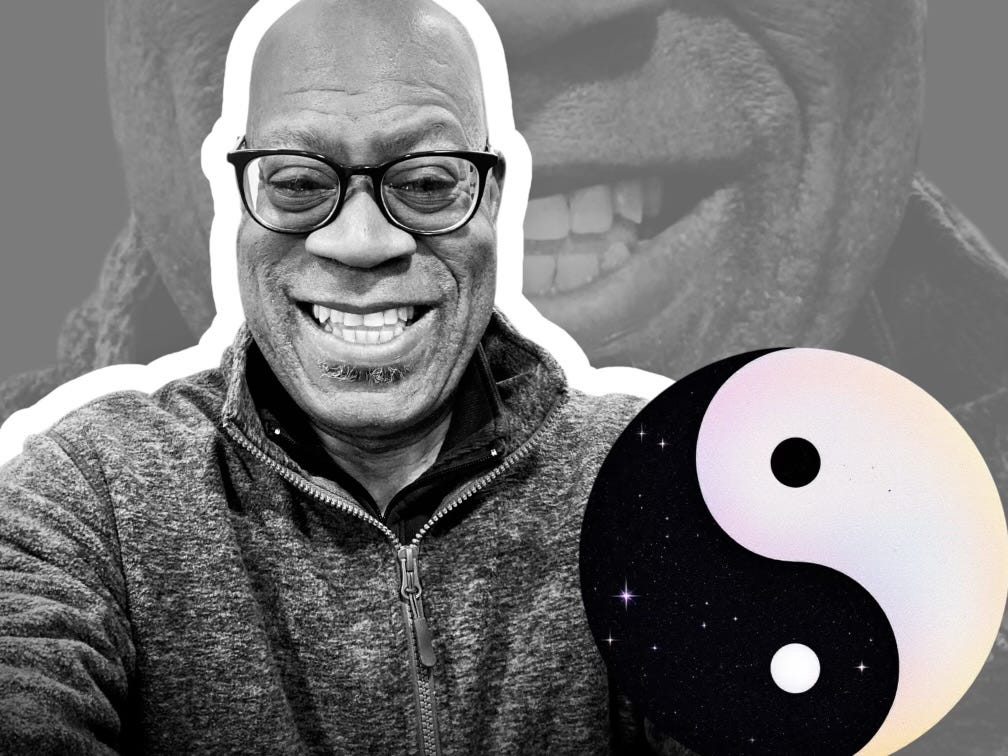I didn’t expect to learn a profound lesson about life from a roundabout. But there I was, sitting at the wheel of my Nissan 300 ZX in Shelbyville, Indiana, staring at a circular intersection like it was some kind of riddle from a Zen master.
This was my first real encounter with a roundabout, and I was baffled….
…..Where were the traffic lights?
…………How did I know when to go?
…………………And most importantly—how the hell did I get out?
My Midwestern upbringing had not prepared me for this. We had stop signs and red lights—clean, definitive moments of “Go” and “Don’t Go.” Life was structured. Orderly. You either had the right of way, or you didn’t.
But a roundabout? It was chaos disguised as efficiency. A never-ending loop of movement with no clear stopping point. It felt like stepping into the void, a metaphor I wouldn’t fully appreciate until years later.
The Circular Way: From Shelbyville to Folsom
That roundabout in Shelbyville was just the beginning. Years later, I found myself traveling through Carmel, Indiana, another town that seemed to have a love affair with circular thoroughfares. This time, I was more prepared, but the lesson remained the same: You enter, you navigate, and when the time is right, you exit.
Simple, right? But as with all things, it’s only simple if you’re paying attention.
Roundabouts, much like life, require presence. You can’t barrel through them with blind certainty the way you can at a four-way stop. You have to feel your way through, adjust your speed, yield when necessary, and commit when it’s time. And above all, you have to know when to get off.
I once missed my exit on a roundabout in Carmel and spent an embarrassing extra lap circling back to where I started. It was a moment of existential comedy. I could hear the infamous song “we’ll go around in circles…” as I spun around like a lost tourist in my own town.
That song, with its funky groove and sly lyrics, suddenly felt like a life anthem. How often do we find ourselves going in circles, unsure of where to exit? Whether it’s a job we’ve outgrown, a toxic relationship, or a belief system that no longer serves us—many of us stay on the merry-go-round far longer than necessary.
The trick, as I was beginning to learn, was to trust the flow and recognize the right moment to move forward.
The I Ching and the Eternal Circle
Taoism, my ever-present philosophical companion, has a deep reverence for the circle. The I Ching, one of its foundational texts, is built on the idea of cyclical change. The ancient hexagrams don’t offer straight-line predictions like Western fortune-telling. Instead, they illustrate movement, transformation, and the natural flow of events.
One of the most significant hexagrams in the I Ching is Hexagram 1, Qian—often associated with pure Yang energy, creativity, and forward movement. But it’s not a straight path. Energy waxes and wanes, seasons shift, and nothing remains static.
Similarly, Hexagram 2, Kun, speaks to the receptive, the yielding force, the ability to move with life rather than against it. The Tao isn’t about stubbornly forcing our way through. Instead, it’s about moving in harmony with the rhythm of existence. Just like a well-navigated roundabout.
The Taoist way isn’t to stop the flow—it’s to understand it. Resistance is what creates suffering. If you fight the roundabout, you’ll find yourself stuck, frustrated, and possibly rear-ended. But if you embrace the movement, yield when needed, and glide forward when the path opens, suddenly everything clicks into place.
How to Exit a Roundabout (and a Stagnant Life)
The lesson of the roundabout is simple but profound — not every exit is for you. Some will be distractions. Others will lead you down dead-end roads. And some will feel right but aren’t quite timed correctly.
Knowing when to exit is a skill. It requires discernment, patience, and self-awareness—qualities that Taoism constantly nudges us toward.
In life, I’ve stayed in roundabouts too long. I’ve clung to familiar but unfulfilling work. I’ve lingered in relationships that should have ended miles ago. I’ve revisited the same old mental loops, worrying over things beyond my control. But as I’ve gotten older (and hopefully wiser), I’ve started to trust the Tao of the roundabout.
If I miss my exit, I don’t panic. I just take another lap, recalibrate, and find the right moment to move.
The Final Turn
Roundabouts, the I Ching, Billy Paul—they all whisper the same message: Life isn’t a straight road with clear signs and predictable stops. It’s a series of interconnected loops, shifting rhythms, and moments of choice.
The Tao doesn’t demand that we figure it all out at once. It just asks that we stay present, embrace the flow, and know that if we’re still going in circles—well, maybe we just haven’t found the right exit yet.
And that’s okay.
Because sometimes, the best lessons aren’t found in the straightest path forward. Sometimes, they're just about the circling.
If you find my nomadic wisdom valuable in helping to set a positive tone for your day, would you be kind enough to consider joining as a paid member supporter.
You can also tip me some dirty chai latte love here if you feel so inclined.
Every bit counts as I strive to deliver high quality feature articles into your inbox on a daily basis. Never any paywalls, just my Taoist raw thoughts which are open to everyone on what it means to be human.
Your contributions are appreciated in support of my full time work and calling.
Much Love,
Diamond- Michael Scott — aka The Chocolate Taoist
PS: Here are a couple of other simple ways you can engage with us
Reshare your favorite takeaway on Substack NOTES
SHARE this article and publication







I drove the roundabouts in England, thoroughly befuddled going in the wrong direction on the wrong side of the road and on the wrong side of the car. There was no muscle memory to guide me. It was like driving for the first time. Maybe we stay in the loop too long not only because we don’t know how to exit, but that the loop itself becomes something we learn to navigate, so why leave? Now, I dare you to give an analogy of the jug handles in New Jersey!
Wonderful analogy!